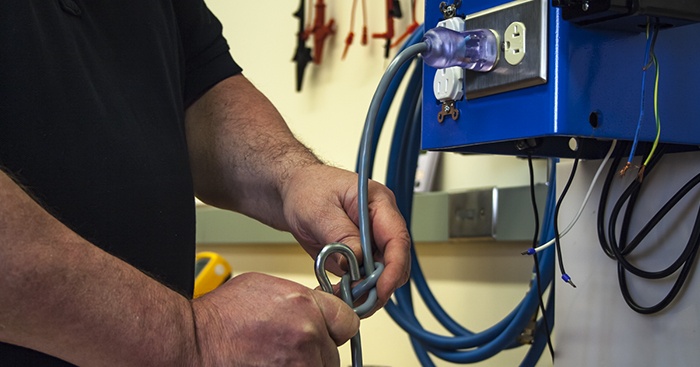An Overview of Interpower Testing
Posted on 4/22/24 9:57 AM

Whether customized cord sets or electrical components for global industries, Interpower’s cords and cord sets are continually tested beyond UL and IEC standards.
“We test more than is required for our own benefit,” Product Development Manager Ron Barnett says. Barnett has been with Interpower since 2005, and has conducted thousands of tests to ensure Interpower cords, cord sets, and components exceed agency standards such as those required from UL and VDE. “The standards, such as the one for the UL 2556 Vertical Flame Test, are bare minimums. We go beyond the standards because it lends better reliability to our design—products become more reliable in that regard.”
Interpower’s Testing Laboratory resides in Ames, Iowa, and is ground zero for most critical tests that determine whether Interpower products such as cords, plugs, sockets, power strips, EMI filters, and other components meet or exceed North American and International standards.
“Some products we test more often than others due to the high volume we manufacture, such as our line of C13 cords and cord sets,” Barnett says.
UL 817 Abrupt Removal Test
In this test, hospital-grade plugs are attached to a 10-lb weight which is dropped to pull apart the connections to see how far the blades have bent, and to see if the wires have been pulled out of the crimp, or broken crimping has been pulled away from the wires.
UL 817 Abrupt Pull Test
The Abrupt Pull Test features a typical NEMA 5-15 plug, not a hospital-grade plug. A 2 ½ pound weight is dropped 25 times from the plug. At the start, three lights on the test equipment glow red showing electrical continuity. However, if during the test one of the three wires “fails” (line, neutral, and ground) and one or more lights go out, the test is considered a failure. If that occurs, the plug is examined to see why the continuity was broken.
Temp-Rise Test
At the Temp-Rise Station, thermocouples attached to components of electrical contacts measure temperature rise. The thermocouples are soldered onto the blades of the plug or connector as to monitor temperature when connected to a power source, such as its rate of rise. By UL 817 standards, if it rises less than 45° Celsius the test is successful (North America). For International Standards such as IEC 60320 and IEC 60884, that margin of error is 30°. A reading is taken every minute as a software program charts the rise in real time. If the temperature is found to rise too quickly, subsequent testing ensues to discover the faulty component(s).
Crimp Cross-Section Test
In this Interpower test, crimp barrels are cut in half, polished, and then washed in acid to produce an extremely smooth finish before testing. Then, the crimped section is photographed under a microscope. The two rounded protrusions of the crimp are called “barrels.” The crimp is composed of several strands of wire, and must be tight enough to maintain contact. New crimps off the assembly line are randomly tested at all manufacturing locations. While a good crimp means a good connection, a poorly crimped cord may cause a fault or a rise in temperature.
Heat and Humidity Chamber
Temperature standards related to component material and function are reasons the Interpower testing lab maintains a Heat Chamber. A heat test may last 8 hours, or 24. The duration will be determined by the type of material, and the standards pertaining to that material.
Breaking Capacity and Normal Operation Test
The Breaking Capacity Test produces arcing as the connections are “live” when they are inserted or pulled apart. The testing machine has a shield which protects the test personnel from severe shock. One important metric of this test is to prove whether arcing tracks along the plastic. If it does, this could cause damage to the component, or worse, start a fire.
Vertical Flame Chamber Test
If a cord burns longer than 60 seconds, it’s a fail. Also, a paper flag hangs along the cord inches above the flame. “If the flame burns more than 25% of the paper flag, that’s a fail,” Barnett says. “We test as many cords as we can since a greater sampling of cords means better data.”
Topics: testing, designing for export, safety, compliance standards, USA Made Products





